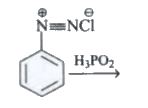Which of the following reaction is employed to produce ozone in the laboratory ?
Exposure of air to UV light
Reaction of F2 with H2O
Reaction of SO2 with H2O2
Passage of silent electric discharge through oxygen
The correct Answer is:D
To determine which reaction is employed to produce ozone (O₃) in the laboratory, we need to analyze the given options based on the known methods of ozone production.
1. Understanding Ozone Production: Ozone is typically produced by supplying energy to diatomic oxygen (O₂). This can be done through methods such as ultraviolet (UV) radiation or silent electric discharge.
2. Evaluating Option 1:
- Exposure of air to UV light: This method does produce ozone, but it is not a controlled laboratory method. It occurs naturally in the atmosphere, particularly in photochemical reactions. Therefore, this option is not correct for laboratory production.
3. Evaluating Option 2:
- Reaction of F₂ with H₂O: The reaction of fluorine gas (F₂) with water (H₂O) produces hydrofluoric acid (HF) and oxygen (O₂), but it does not produce ozone. Thus, this option is also incorrect.
4. Evaluating Option 3:
- Reaction of sulfur dioxide (SO₂) with H₂O: This reaction leads to the formation of sulfuric acid (H₂SO₄) and does not produce ozone. Therefore, this option is not correct.
5. Evaluating Option 4:
- Passage of silent electric discharge through oxygen: This method is a well-known laboratory technique for producing ozone. When an electric discharge is passed through oxygen, ozone is formed. This is the correct method for laboratory production of ozone.
Conclusion:
The correct answer is Option 4: Passage of silent electric discharge through oxygen.
- Exposure of air to UV light: This method does produce ozone, but it is not a controlled laboratory method. It occurs naturally in the atmosphere, particularly in photochemical reactions. Therefore, this option is not correct for laboratory production.
- Reaction of F₂ with H₂O: The reaction of fluorine gas (F₂) with water (H₂O) produces hydrofluoric acid (HF) and oxygen (O₂), but it does not produce ozone. Thus, this option is also incorrect.
- Reaction of sulfur dioxide (SO₂) with H₂O: This reaction leads to the formation of sulfuric acid (H₂SO₄) and does not produce ozone. Therefore, this option is not correct.
- Passage of silent electric discharge through oxygen: This method is a well-known laboratory technique for producing ozone. When an electric discharge is passed through oxygen, ozone is formed. This is the correct method for laboratory production of ozone.
The correct answer is Option 4: Passage of silent electric discharge through oxygen.
Similar Questions
Knowledge Check
Which of the following reactions will produce benzene ?
A B3HC≡CHFeorCo−−−−−→ΔC
B3HC≡CHFeorCo−−−−−→ΔC D
D
Which of the following reactions will produce aldehyde?
A BH3C−CH=CH2CO+H2−−−−−−−→CO2(CO)8CH3C−C≡CH−−−−−→OϴH/H2ODH3C−C−o=ChHg+2,H2SO4−−−−−−−−→
BH3C−CH=CH2CO+H2−−−−−−−→CO2(CO)8CH3C−C≡CH−−−−−→OϴH/H2ODH3C−C−o=ChHg+2,H2SO4−−−−−−−−→Which of the following reactions produce the same product?
A B
B C
C D
D
Which of the following reaction produces hydrogen ?
View SolutionWhich of the following reaction does not produce H3PO4?
View SolutionIn which of the following reactions H2(g) is produced?
View SolutionWhich of the following reactions produce the same product?
View SolutionWhich of the following reactions would produce same product?
View Solution
